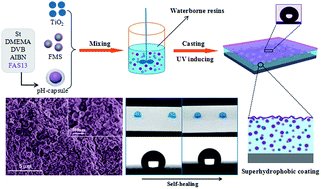Environmental stimuli-responsive self-repairing waterbased superhydrophobic coatings
Abstract
Superhydrophobic coatings have received great attention over the past decades because of their specific performances, but most of them may lose their superhydrophobicity under harsh conditions especially in outdoor applications. In this paper, UV and pH dual stimuli-responsive self-repairing waterbased superhydrophobic coatings were prepared based on TiO2 with photocatalysis and pH-responsive microcapsules, which were durable against UV irradiation and chemically stable in contact with alkaline or acidic aqueous solutions. These coatings are an environment-friendly waterborne system and could be easily coated on various substrates. What is more, they can restore their superhydrophobicity and self-cleaning ability under UV light even after mechanically damaged or contaminated with organics. Moreover, this superhydrophobic coating was immersed into 5 wt% NaCl aqueous solutions for 24 h or underwent ten icing/melting cycles, their surfaces could also recover the superhydrophobicity under pH or UV stimuli.



 Please wait while we load your content...
Please wait while we load your content...